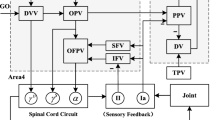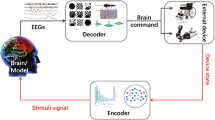Abstract
Brain–machine interface (BMI) can realize information interaction between the brain and external devices, and yet the control accuracy is limited by the change of electroencephalogram signals. The introduction of auxiliary controller can overcome the above problems, but the performance of different auxiliary controllers is quite different. Hence, in this paper, we comprehensively compare and analyze the performance of different auxiliary controllers to provide a theoretical basis for designing BMI system. The main work includes: (1) designing four kinds of auxiliary controllers based on simultaneous perturbation stochastic approximation-function approximator (SPSA-FA), iterative feedback tuning-PID (IFT-PID), model predictive control (MPC) and model-free control (MFC); (2) based on the model of improved single-joint information transmission, constructing the closed-loop BMI systems with the decoder-based Wiener filter; and (3) comparing their performance in the constructed closed-loop BMI systems for dynamic motion restoration. The results show that the order of tracking accuracy is MPC, IFT-PID, SPSA-FA, MFC, and the order of time consumed is opposite. A good control effectiveness is achieved at the expense of time, so a suitable auxiliary controller should be selected according to the actual requirements.








Similar content being viewed by others
References
Agashe H, Paek A, Contreras-Vidal J (2016) Multisession, noninvasive closed-loop neuroprosthetic control of grasping by upper limb amputees. Prog Brain Res 228:107–129
An HD, Wang PT, King CE et al (2013) Brain–computer interface controlled robotic gait orthosis. J Neuroeng Rehabil 10(1):1–9
Bendevis P, Karam A, Laleg-Kirati T (2020) Optimal model-free control of solar thermal membrane distillation system. Comput Chem Eng 133(2):106622.1-106622.7
Bullock D, Cisek P, Grossberg S (1998) Cortical networks for control of voluntary arm movements under variable force conditions. Cereb Cortex 2(8):48–62
Dadarlat M, O’Doherty J, Sabes P (2014) A learning-based approach to artificial sensory feedback leads to optimal integration. Nat Neurosci 18(1):138–144
Dangi S, Gowda S, Heliot R et al (2011) Adaptive Kalman filtering for closed-loop brain–machine interface systems. In: 2011 5th International IEEE/EMBS conference on neural engineering (NER), pp 609–612
Filimon F (2010) Human cortical control of hand movements: parietofrontal networks for reaching, grasping, and pointing. Neuroscientist 16(4):388–407
Fleming J, Cannon M (2018) Stochastic MPC for additive and multiplicative uncertainty using sample approximations. IEEE Trans Autom Control 64(9):3883–3888
García-Córdova F (2007) A cortical network for control of voluntary movements in a robot finger. Neurocomputing 71(1):374–391
He F, Bi L, Yun L et al (2017) Model predictive control for a brain-controlled mobile robot. In: 2017 IEEE International conference on systems, man and cybernetics (SMC), pp 3184–3188
He Y, Eguren D, Azorín JM et al (2018) Brain–machine interfaces for controlling lower-limb powered robotic systems. J Neural Eng 15(2):021004.1-021004.15
Heertjes M, Bart V, Oomen T (2016) Constrained iterative feedback tuning for robust control of a wafer stage system. IEEE Trans Control Syst Technol 24(1):56–66
Héliot R, Ganguly K, Jimenez J et al (2010) Learning in closed-loop brain–machine interfaces: modeling and experimental validation. IEEE Trans Syst Man Cybern Part B Cybern 40(5):1387–1397
Hettiarachchi I, Babaei T, Nguyen T et al (2018) A fresh look at functional link neural network for motor imagery-based brain–computer interface. J Neurosci Methods 305:28–35
Hong YY, Chang HL, Chiu C (2010) Hour-ahead wind power and speed forecasting using simultaneous perturbation stochastic approximation (SPSA) algorithm and neural network with fuzzy inputs. Energy 35(9):3870–3876
Kamrunnahar M, Dias NS, Schiff SJ (2011) Toward a model-based predictive controller design in brain–computer interfaces. Ann Biomed Eng 39(5):1482–1492
Kim S, Sanchez J, Rao Y et al (2006) A comparison of optimal MIMO linear and nonlinear models for brain–machine interfaces. J Neural Eng 3(2):145–161
Lebedev M, Nicolelis M (2006) Brain–machine interfaces: past, present and future. Trends Neurosci 29(9):536–546
Li M, Zhu Y, Yang KM et al (2019a) Convergence rate oriented iterative feedback tuning with application to an ultraprecision wafer stage. IEEE Trans Industr Electron 66(3):1993–2003
Li Z, Li J, Zhao S et al (2019b) Adaptive neural control of a kinematically redundant exoskeleton robot using brain–machine interfaces. IEEE Trans Neural Netw Learn Syst 30(12):3558–3571
Liu X, Zhang M, Richardson AG et al (2017) Design of a closed-loop, bidirectional brain–machine interface system with energy efficient neural feature extraction and PID control. IEEE Trans Biomed Circuits Syst 11(4):729–742
London BM, Jordan LR, Jackson CR et al (2008) Electrical stimulation of the proprioceptive cortex (area 3a) used to instruct a behaving monkey. IEEE Trans Neural Syst Rehabil Eng 16(1):32–36
Lu WJ, Zhu PP, Ferrari S (2016) A hybrid-adaptive dynamic programming approach for the model-free control of nonlinear switched systems. IEEE Trans Autom Control 61(10):3203–3208
Lu Y, Bi L (2021) Human behavior model-based predictive control of longitudinal brain-controlled driving. IEEE Trans Intell Transp Syst 22(3):1361–1374
Lu Y, Bi L, Li H (2020) Model predictive-based shared control for brain-controlled driving. IEEE Trans Intell Transp Syst 21(2):630–640
Moorman HG, Gowda S, Carmena JM (2016) Control of redundant kinematic degrees of freedom in a closed-loop brain–machine interface. IEEE Trans Neural Syst Rehabil Eng 25(6):750–760
Mrachaczkersting N, Ning J, Stevenson AJT et al (2016) Efficient neuroplasticity induction in chronic stroke patients by an associative brain–computer interface. J Neurophysiol 115(3):1410–1421
Orsborn A (2013) Closed-loop design of brain–machine interface systems. PhD thesis, UC Berkeley
Pan H, Mi W, Lei X et al (2020a) A closed-loop brain–machine interface framework design for motor rehabilitation. Biomed Signal Process Control 58:101877.1-101877.9
Pan H, Mi W, Wen F et al (2020b) An adaptive decoder design based on the receding horizon optimization in BMI system. Cogn Neurodyn 14(3):281–290
Pan HG, Mi WY, Lei XY et al (2020c) A closed-loop BMI system design based on the improved SJIT model and the network of Izhikevich neurons. Neurocomputing 401(3):271–280
Pashaie R, Baumgartner R, Richner TJ et al (2015) Closed-loop optogenetic brain interface. IEEE Trans Biomed Eng 62(10):2327–2337
Precup RE, Preitl S, Rudas IJ et al (2008) Design and experiments for a class of fuzzy controlled servo systems. IEEE Trans Mechatron 13(1):22–35
Qiu SY, Li ZJ, He W et al (2016) Teleoperation control of an exoskeleton robot using brain–machine interface and visual compressive sensing. IEEE Trans Fuzzy Syst 25(1):58–69
Qiu S, Li Z, Wei H et al (2017) Brain–machine interface and visual compressive sensing-based teleoperation control of an exoskeleton robot. IEEE Trans Fuzzy Syst 25(1):58–69
Quick KM, Weiss JM, Clemente F et al (2020) Intracortical microstimulation feedback improves grasp force accuracy in a human using a brain–computer interface. In: 2020 42nd Annual international conference of the IEEE engineering in medicine and biology society (EMBC), pp 3355–3358
Shanechi MM (2017) Brain–machine interface control algorithms. IEEE Trans Neural Syst Rehabil Eng 25(10):1725–1734
Shanechi M, Orsborn A, Moorman H et al (2014) High-performance brain–machine interface enabled by an adaptive optimal feedback-controlled point process decoder. In: Engineering in medicine and biology society
Son D, Choi H (2019) Iterative feedback tuning of the proportional–integral–differential control of flow over a circular cylinder. IEEE Trans Control Syst Technol 27(4):1385–1396
Spall JC (2002) Multivariate stochastic approximation using a simultaneous perturbation gradient approximation. IEEE Trans Autom Control 37(3):332–341
Sussillo D, Nuyujukian P, Fan J et al (2012) A recurrent neural network for closed-loop intracortical brain–machine interface decoders. J Neural Eng 9(2):026027.1-026027.10
Tang W, Daoutidis P (2021) Dissipativity learning control (DLC): theoretical foundations of input–output data-driven model-free control. Syst Control Lett 147:104831.1-104831.9
Vidaurre C, Klauer C, Schauer T et al (2016) EEG-based BCI for the linear control of an upper-limb neuroprosthesis. Med Eng Phys 38(11):1195–1204
Wagh S, Kamath A (2012) Model predictive control. J Control Sci Eng 8:5
Witkowski M, Cortese M, Cempini M et al (2014) Enhancing brain–machine interface (bmi) control of a hand exoskeleton using electrooculography (EOG). J Neuroeng Rehabil 11(1):165–171
Yang Y, Qiao S, Sani OG et al (2021) Modelling and prediction of the dynamic responses of large-scale brain networks during direct electrical stimulation. Nat Biomed Eng 5:324–345
Author information
Authors and Affiliations
Corresponding author
Ethics declarations
Conflict of interest
The authors declare that they have no conflict of interest.
Additional information
Communicated by Benjamin Lindner.
Publisher's Note
Springer Nature remains neutral with regard to jurisdictional claims in published maps and institutional affiliations.
Supplementary Information
Below is the link to the electronic supplementary material.
Rights and permissions
About this article
Cite this article
Pan, H., Song, H., Zhang, Q. et al. Auxiliary controller design and performance comparative analysis in closed-loop brain–machine interface system. Biol Cybern 116, 23–32 (2022). https://doi.org/10.1007/s00422-021-00897-3
Received:
Accepted:
Published:
Issue Date:
DOI: https://doi.org/10.1007/s00422-021-00897-3




